Primary Health Care Nursing Roles in Prevention of HIV/AIDS Exposure
VerifiedAdded on 2021/01/03
|10
|2753
|296
Report
AI Summary
This report comprehensively examines the pivotal roles of primary health care nurses in preventing HIV/AIDS exposure among vulnerable populations. It emphasizes the importance of primary health care as a society-wide approach to well-being, highlighting nursing's critical functions in disease prevention, treatment, and patient care. The report details the social determinants of health and their impact on health inequalities, particularly concerning HIV/AIDS. It explores various nursing interventions, including community education, risk management, and patient support, to reduce the spread of HIV and improve patient outcomes. The report also delves into the clinical aspects of HIV infection, including transmission, stages of the disease, and the importance of early diagnosis and treatment. It concludes by underscoring the significance of nurses in addressing public health crises and advocating for better healthcare access and equality.
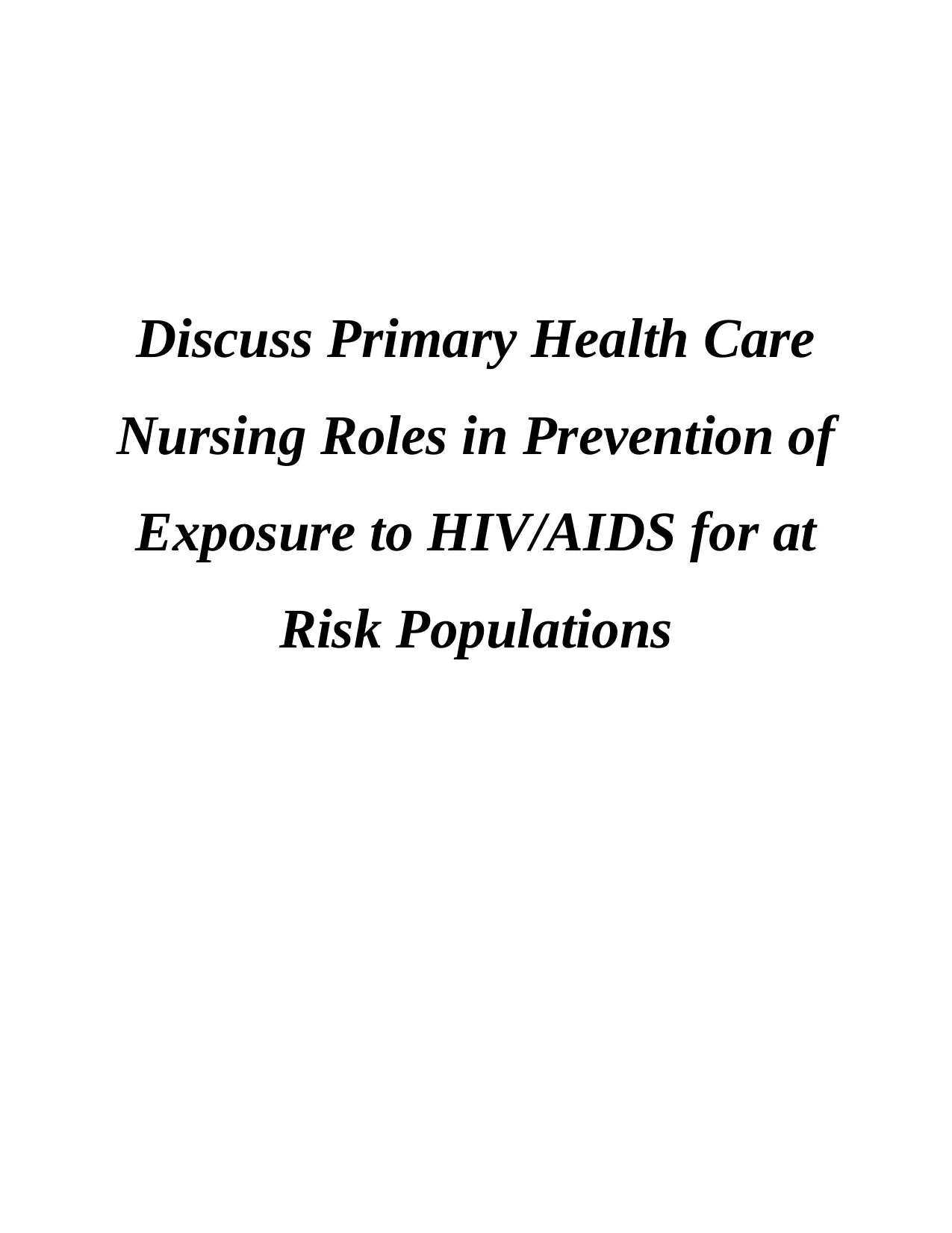
Discuss Primary Health Care
Nursing Roles in Prevention of
Exposure to HIV/AIDS for at
Risk Populations
Nursing Roles in Prevention of
Exposure to HIV/AIDS for at
Risk Populations
Paraphrase This Document
Need a fresh take? Get an instant paraphrase of this document with our AI Paraphraser
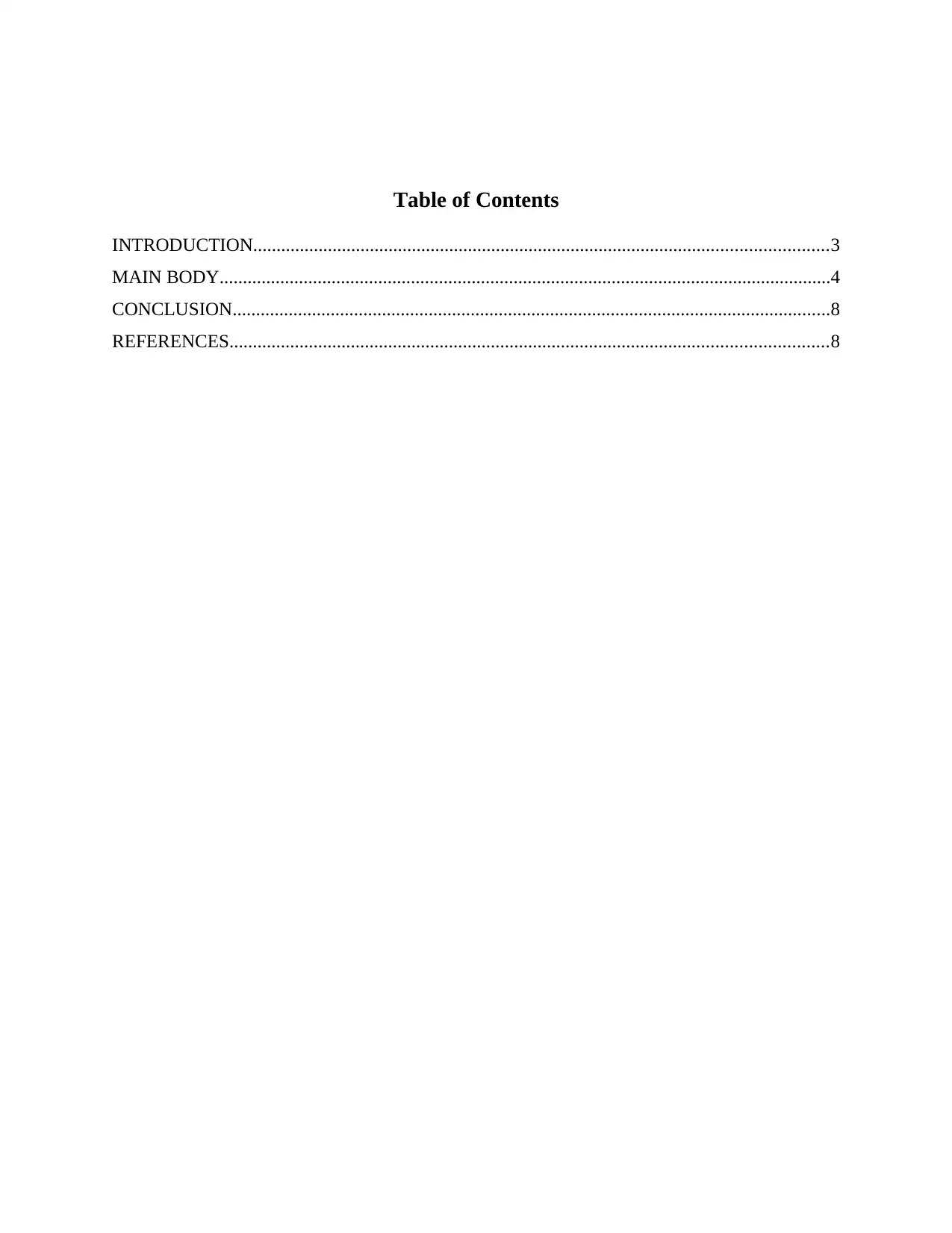
Table of Contents
INTRODUCTION...........................................................................................................................3
MAIN BODY...................................................................................................................................4
CONCLUSION................................................................................................................................8
REFERENCES................................................................................................................................8
INTRODUCTION...........................................................................................................................3
MAIN BODY...................................................................................................................................4
CONCLUSION................................................................................................................................8
REFERENCES................................................................................................................................8
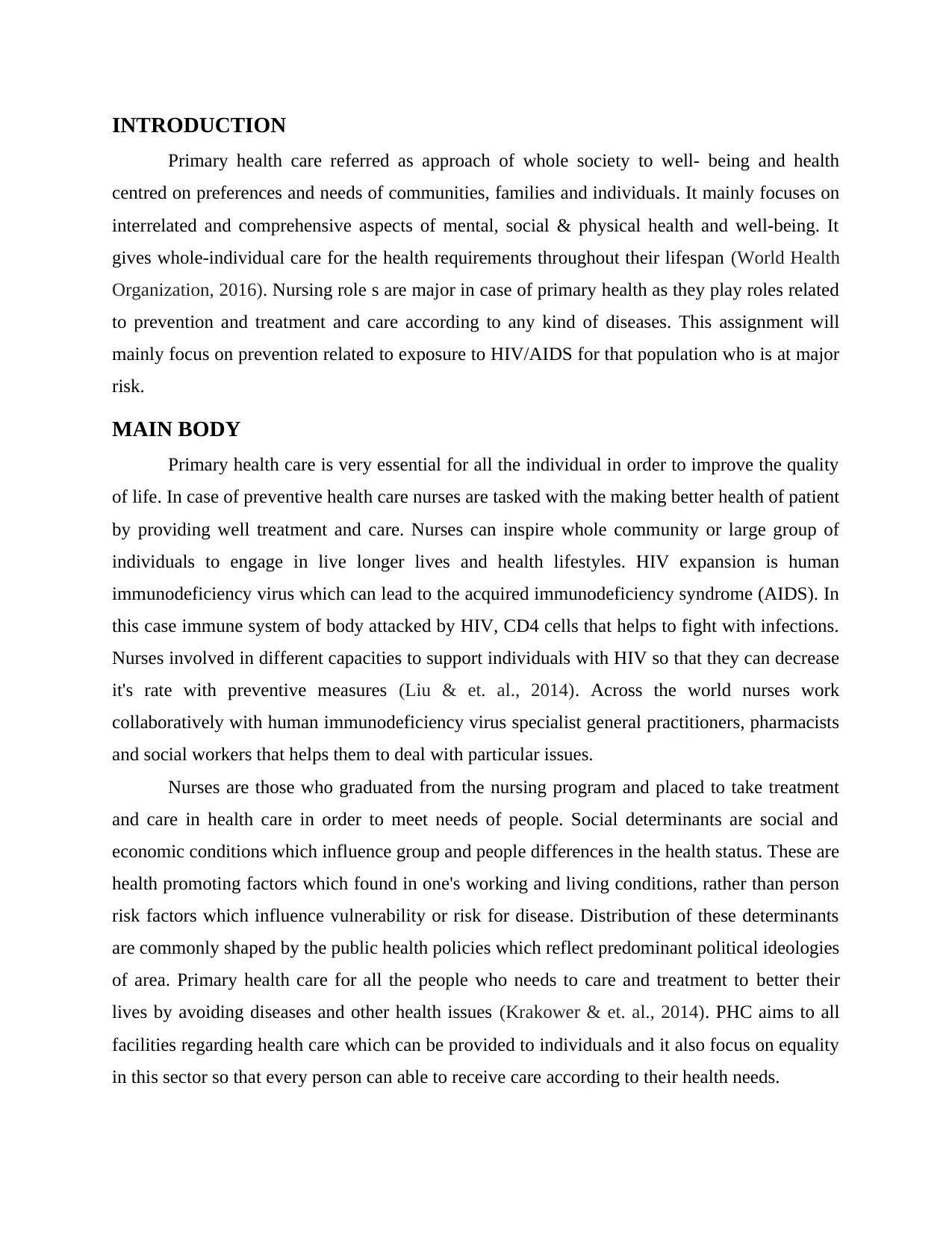
INTRODUCTION
Primary health care referred as approach of whole society to well- being and health
centred on preferences and needs of communities, families and individuals. It mainly focuses on
interrelated and comprehensive aspects of mental, social & physical health and well-being. It
gives whole-individual care for the health requirements throughout their lifespan (World Health
Organization, 2016). Nursing role s are major in case of primary health as they play roles related
to prevention and treatment and care according to any kind of diseases. This assignment will
mainly focus on prevention related to exposure to HIV/AIDS for that population who is at major
risk.
MAIN BODY
Primary health care is very essential for all the individual in order to improve the quality
of life. In case of preventive health care nurses are tasked with the making better health of patient
by providing well treatment and care. Nurses can inspire whole community or large group of
individuals to engage in live longer lives and health lifestyles. HIV expansion is human
immunodeficiency virus which can lead to the acquired immunodeficiency syndrome (AIDS). In
this case immune system of body attacked by HIV, CD4 cells that helps to fight with infections.
Nurses involved in different capacities to support individuals with HIV so that they can decrease
it's rate with preventive measures (Liu & et. al., 2014). Across the world nurses work
collaboratively with human immunodeficiency virus specialist general practitioners, pharmacists
and social workers that helps them to deal with particular issues.
Nurses are those who graduated from the nursing program and placed to take treatment
and care in health care in order to meet needs of people. Social determinants are social and
economic conditions which influence group and people differences in the health status. These are
health promoting factors which found in one's working and living conditions, rather than person
risk factors which influence vulnerability or risk for disease. Distribution of these determinants
are commonly shaped by the public health policies which reflect predominant political ideologies
of area. Primary health care for all the people who needs to care and treatment to better their
lives by avoiding diseases and other health issues (Krakower & et. al., 2014). PHC aims to all
facilities regarding health care which can be provided to individuals and it also focus on equality
in this sector so that every person can able to receive care according to their health needs.
Primary health care referred as approach of whole society to well- being and health
centred on preferences and needs of communities, families and individuals. It mainly focuses on
interrelated and comprehensive aspects of mental, social & physical health and well-being. It
gives whole-individual care for the health requirements throughout their lifespan (World Health
Organization, 2016). Nursing role s are major in case of primary health as they play roles related
to prevention and treatment and care according to any kind of diseases. This assignment will
mainly focus on prevention related to exposure to HIV/AIDS for that population who is at major
risk.
MAIN BODY
Primary health care is very essential for all the individual in order to improve the quality
of life. In case of preventive health care nurses are tasked with the making better health of patient
by providing well treatment and care. Nurses can inspire whole community or large group of
individuals to engage in live longer lives and health lifestyles. HIV expansion is human
immunodeficiency virus which can lead to the acquired immunodeficiency syndrome (AIDS). In
this case immune system of body attacked by HIV, CD4 cells that helps to fight with infections.
Nurses involved in different capacities to support individuals with HIV so that they can decrease
it's rate with preventive measures (Liu & et. al., 2014). Across the world nurses work
collaboratively with human immunodeficiency virus specialist general practitioners, pharmacists
and social workers that helps them to deal with particular issues.
Nurses are those who graduated from the nursing program and placed to take treatment
and care in health care in order to meet needs of people. Social determinants are social and
economic conditions which influence group and people differences in the health status. These are
health promoting factors which found in one's working and living conditions, rather than person
risk factors which influence vulnerability or risk for disease. Distribution of these determinants
are commonly shaped by the public health policies which reflect predominant political ideologies
of area. Primary health care for all the people who needs to care and treatment to better their
lives by avoiding diseases and other health issues (Krakower & et. al., 2014). PHC aims to all
facilities regarding health care which can be provided to individuals and it also focus on equality
in this sector so that every person can able to receive care according to their health needs.
⊘ This is a preview!⊘
Do you want full access?
Subscribe today to unlock all pages.

Trusted by 1+ million students worldwide
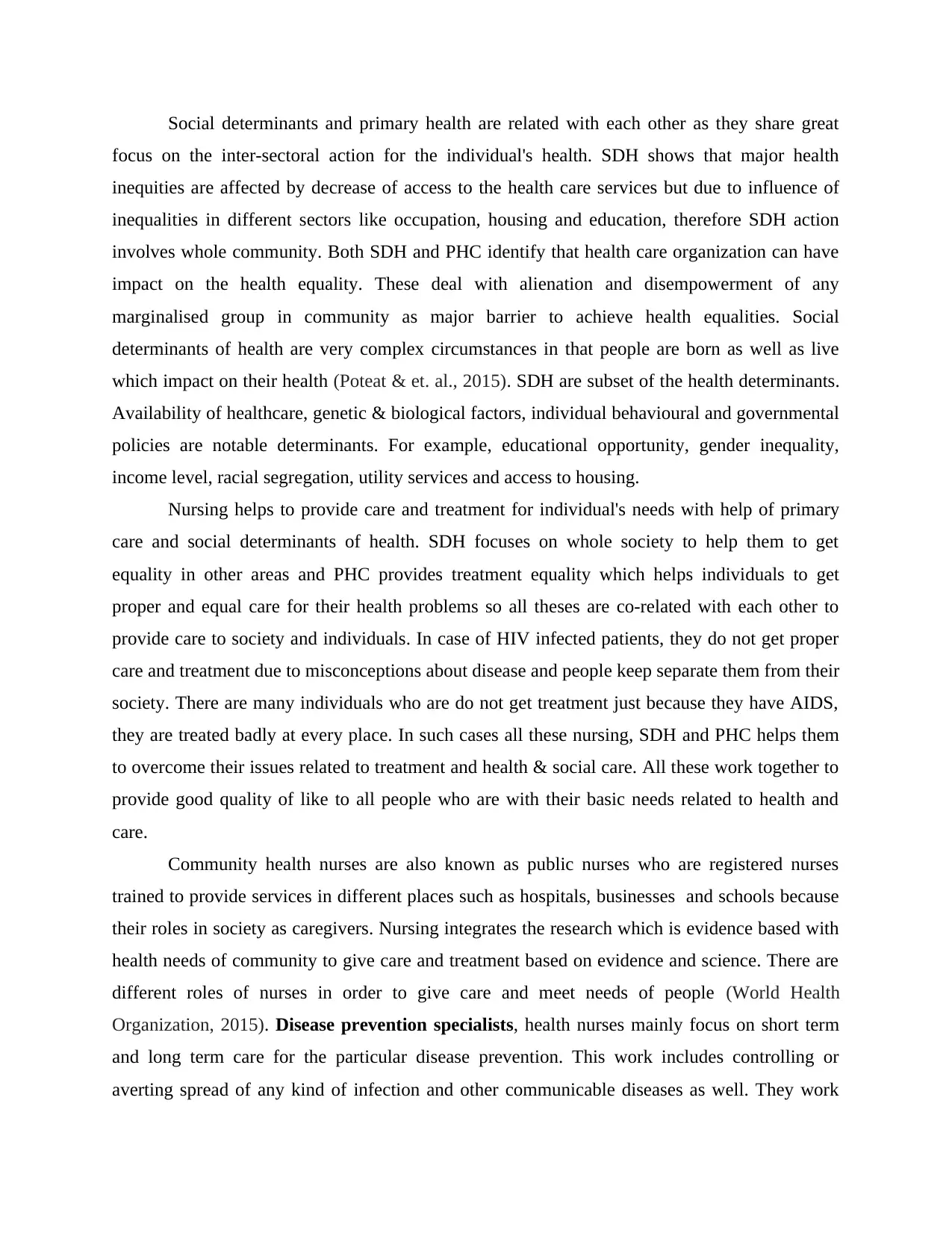
Social determinants and primary health are related with each other as they share great
focus on the inter-sectoral action for the individual's health. SDH shows that major health
inequities are affected by decrease of access to the health care services but due to influence of
inequalities in different sectors like occupation, housing and education, therefore SDH action
involves whole community. Both SDH and PHC identify that health care organization can have
impact on the health equality. These deal with alienation and disempowerment of any
marginalised group in community as major barrier to achieve health equalities. Social
determinants of health are very complex circumstances in that people are born as well as live
which impact on their health (Poteat & et. al., 2015). SDH are subset of the health determinants.
Availability of healthcare, genetic & biological factors, individual behavioural and governmental
policies are notable determinants. For example, educational opportunity, gender inequality,
income level, racial segregation, utility services and access to housing.
Nursing helps to provide care and treatment for individual's needs with help of primary
care and social determinants of health. SDH focuses on whole society to help them to get
equality in other areas and PHC provides treatment equality which helps individuals to get
proper and equal care for their health problems so all theses are co-related with each other to
provide care to society and individuals. In case of HIV infected patients, they do not get proper
care and treatment due to misconceptions about disease and people keep separate them from their
society. There are many individuals who are do not get treatment just because they have AIDS,
they are treated badly at every place. In such cases all these nursing, SDH and PHC helps them
to overcome their issues related to treatment and health & social care. All these work together to
provide good quality of like to all people who are with their basic needs related to health and
care.
Community health nurses are also known as public nurses who are registered nurses
trained to provide services in different places such as hospitals, businesses and schools because
their roles in society as caregivers. Nursing integrates the research which is evidence based with
health needs of community to give care and treatment based on evidence and science. There are
different roles of nurses in order to give care and meet needs of people (World Health
Organization, 2015). Disease prevention specialists, health nurses mainly focus on short term
and long term care for the particular disease prevention. This work includes controlling or
averting spread of any kind of infection and other communicable diseases as well. They work
focus on the inter-sectoral action for the individual's health. SDH shows that major health
inequities are affected by decrease of access to the health care services but due to influence of
inequalities in different sectors like occupation, housing and education, therefore SDH action
involves whole community. Both SDH and PHC identify that health care organization can have
impact on the health equality. These deal with alienation and disempowerment of any
marginalised group in community as major barrier to achieve health equalities. Social
determinants of health are very complex circumstances in that people are born as well as live
which impact on their health (Poteat & et. al., 2015). SDH are subset of the health determinants.
Availability of healthcare, genetic & biological factors, individual behavioural and governmental
policies are notable determinants. For example, educational opportunity, gender inequality,
income level, racial segregation, utility services and access to housing.
Nursing helps to provide care and treatment for individual's needs with help of primary
care and social determinants of health. SDH focuses on whole society to help them to get
equality in other areas and PHC provides treatment equality which helps individuals to get
proper and equal care for their health problems so all theses are co-related with each other to
provide care to society and individuals. In case of HIV infected patients, they do not get proper
care and treatment due to misconceptions about disease and people keep separate them from their
society. There are many individuals who are do not get treatment just because they have AIDS,
they are treated badly at every place. In such cases all these nursing, SDH and PHC helps them
to overcome their issues related to treatment and health & social care. All these work together to
provide good quality of like to all people who are with their basic needs related to health and
care.
Community health nurses are also known as public nurses who are registered nurses
trained to provide services in different places such as hospitals, businesses and schools because
their roles in society as caregivers. Nursing integrates the research which is evidence based with
health needs of community to give care and treatment based on evidence and science. There are
different roles of nurses in order to give care and meet needs of people (World Health
Organization, 2015). Disease prevention specialists, health nurses mainly focus on short term
and long term care for the particular disease prevention. This work includes controlling or
averting spread of any kind of infection and other communicable diseases as well. They work
Paraphrase This Document
Need a fresh take? Get an instant paraphrase of this document with our AI Paraphraser
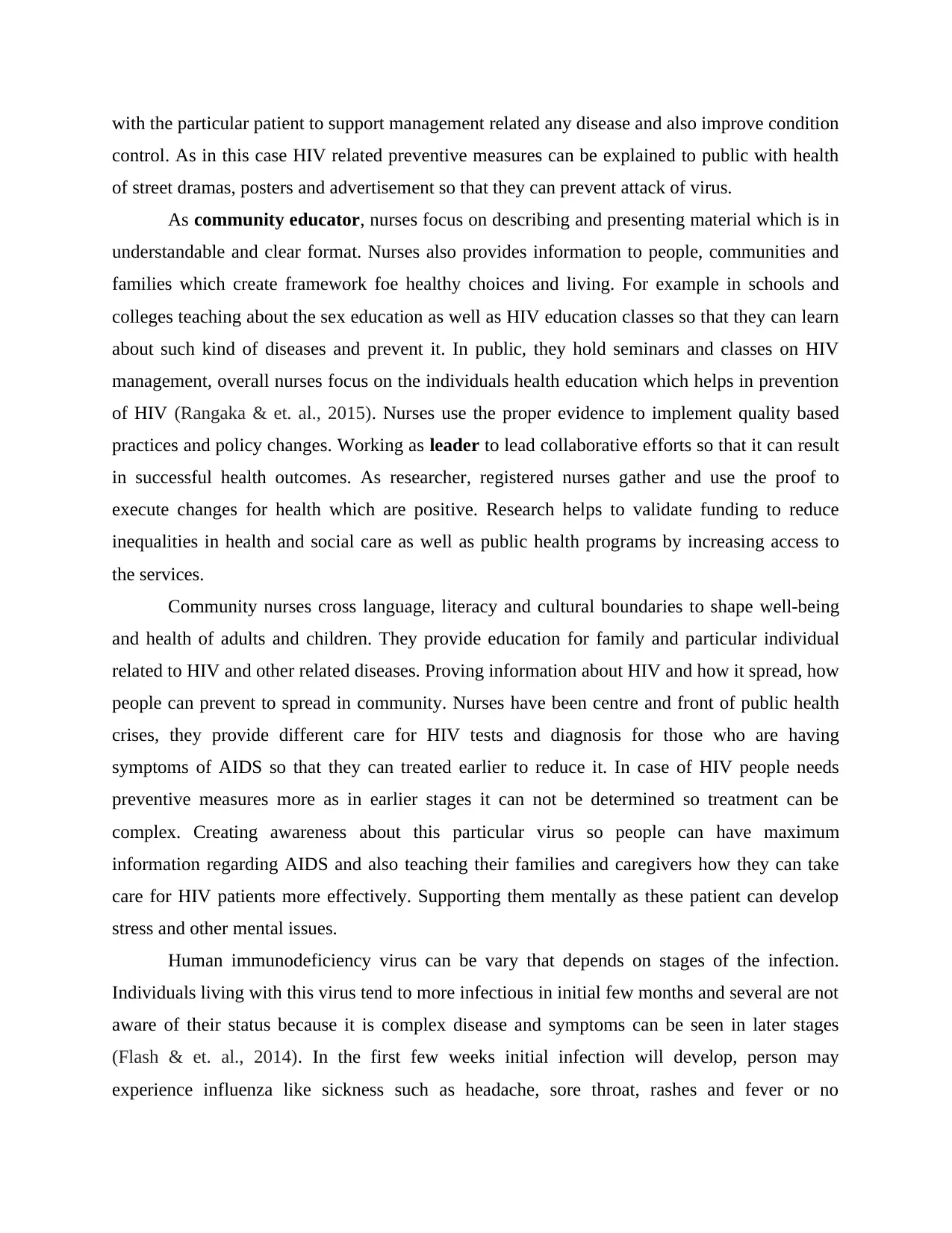
with the particular patient to support management related any disease and also improve condition
control. As in this case HIV related preventive measures can be explained to public with health
of street dramas, posters and advertisement so that they can prevent attack of virus.
As community educator, nurses focus on describing and presenting material which is in
understandable and clear format. Nurses also provides information to people, communities and
families which create framework foe healthy choices and living. For example in schools and
colleges teaching about the sex education as well as HIV education classes so that they can learn
about such kind of diseases and prevent it. In public, they hold seminars and classes on HIV
management, overall nurses focus on the individuals health education which helps in prevention
of HIV (Rangaka & et. al., 2015). Nurses use the proper evidence to implement quality based
practices and policy changes. Working as leader to lead collaborative efforts so that it can result
in successful health outcomes. As researcher, registered nurses gather and use the proof to
execute changes for health which are positive. Research helps to validate funding to reduce
inequalities in health and social care as well as public health programs by increasing access to
the services.
Community nurses cross language, literacy and cultural boundaries to shape well-being
and health of adults and children. They provide education for family and particular individual
related to HIV and other related diseases. Proving information about HIV and how it spread, how
people can prevent to spread in community. Nurses have been centre and front of public health
crises, they provide different care for HIV tests and diagnosis for those who are having
symptoms of AIDS so that they can treated earlier to reduce it. In case of HIV people needs
preventive measures more as in earlier stages it can not be determined so treatment can be
complex. Creating awareness about this particular virus so people can have maximum
information regarding AIDS and also teaching their families and caregivers how they can take
care for HIV patients more effectively. Supporting them mentally as these patient can develop
stress and other mental issues.
Human immunodeficiency virus can be vary that depends on stages of the infection.
Individuals living with this virus tend to more infectious in initial few months and several are not
aware of their status because it is complex disease and symptoms can be seen in later stages
(Flash & et. al., 2014). In the first few weeks initial infection will develop, person may
experience influenza like sickness such as headache, sore throat, rashes and fever or no
control. As in this case HIV related preventive measures can be explained to public with health
of street dramas, posters and advertisement so that they can prevent attack of virus.
As community educator, nurses focus on describing and presenting material which is in
understandable and clear format. Nurses also provides information to people, communities and
families which create framework foe healthy choices and living. For example in schools and
colleges teaching about the sex education as well as HIV education classes so that they can learn
about such kind of diseases and prevent it. In public, they hold seminars and classes on HIV
management, overall nurses focus on the individuals health education which helps in prevention
of HIV (Rangaka & et. al., 2015). Nurses use the proper evidence to implement quality based
practices and policy changes. Working as leader to lead collaborative efforts so that it can result
in successful health outcomes. As researcher, registered nurses gather and use the proof to
execute changes for health which are positive. Research helps to validate funding to reduce
inequalities in health and social care as well as public health programs by increasing access to
the services.
Community nurses cross language, literacy and cultural boundaries to shape well-being
and health of adults and children. They provide education for family and particular individual
related to HIV and other related diseases. Proving information about HIV and how it spread, how
people can prevent to spread in community. Nurses have been centre and front of public health
crises, they provide different care for HIV tests and diagnosis for those who are having
symptoms of AIDS so that they can treated earlier to reduce it. In case of HIV people needs
preventive measures more as in earlier stages it can not be determined so treatment can be
complex. Creating awareness about this particular virus so people can have maximum
information regarding AIDS and also teaching their families and caregivers how they can take
care for HIV patients more effectively. Supporting them mentally as these patient can develop
stress and other mental issues.
Human immunodeficiency virus can be vary that depends on stages of the infection.
Individuals living with this virus tend to more infectious in initial few months and several are not
aware of their status because it is complex disease and symptoms can be seen in later stages
(Flash & et. al., 2014). In the first few weeks initial infection will develop, person may
experience influenza like sickness such as headache, sore throat, rashes and fever or no
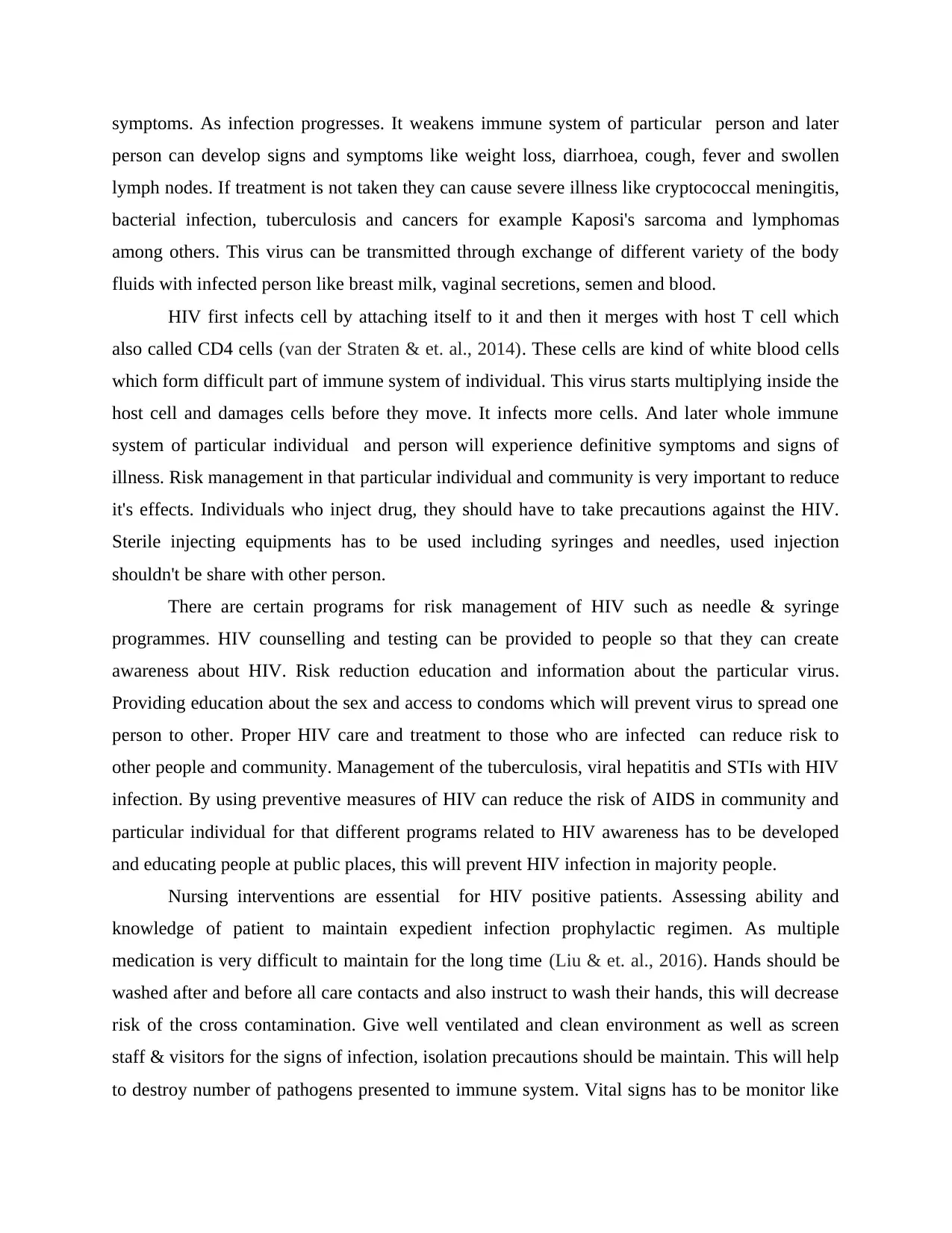
symptoms. As infection progresses. It weakens immune system of particular person and later
person can develop signs and symptoms like weight loss, diarrhoea, cough, fever and swollen
lymph nodes. If treatment is not taken they can cause severe illness like cryptococcal meningitis,
bacterial infection, tuberculosis and cancers for example Kaposi's sarcoma and lymphomas
among others. This virus can be transmitted through exchange of different variety of the body
fluids with infected person like breast milk, vaginal secretions, semen and blood.
HIV first infects cell by attaching itself to it and then it merges with host T cell which
also called CD4 cells (van der Straten & et. al., 2014). These cells are kind of white blood cells
which form difficult part of immune system of individual. This virus starts multiplying inside the
host cell and damages cells before they move. It infects more cells. And later whole immune
system of particular individual and person will experience definitive symptoms and signs of
illness. Risk management in that particular individual and community is very important to reduce
it's effects. Individuals who inject drug, they should have to take precautions against the HIV.
Sterile injecting equipments has to be used including syringes and needles, used injection
shouldn't be share with other person.
There are certain programs for risk management of HIV such as needle & syringe
programmes. HIV counselling and testing can be provided to people so that they can create
awareness about HIV. Risk reduction education and information about the particular virus.
Providing education about the sex and access to condoms which will prevent virus to spread one
person to other. Proper HIV care and treatment to those who are infected can reduce risk to
other people and community. Management of the tuberculosis, viral hepatitis and STIs with HIV
infection. By using preventive measures of HIV can reduce the risk of AIDS in community and
particular individual for that different programs related to HIV awareness has to be developed
and educating people at public places, this will prevent HIV infection in majority people.
Nursing interventions are essential for HIV positive patients. Assessing ability and
knowledge of patient to maintain expedient infection prophylactic regimen. As multiple
medication is very difficult to maintain for the long time (Liu & et. al., 2016). Hands should be
washed after and before all care contacts and also instruct to wash their hands, this will decrease
risk of the cross contamination. Give well ventilated and clean environment as well as screen
staff & visitors for the signs of infection, isolation precautions should be maintain. This will help
to destroy number of pathogens presented to immune system. Vital signs has to be monitor like
person can develop signs and symptoms like weight loss, diarrhoea, cough, fever and swollen
lymph nodes. If treatment is not taken they can cause severe illness like cryptococcal meningitis,
bacterial infection, tuberculosis and cancers for example Kaposi's sarcoma and lymphomas
among others. This virus can be transmitted through exchange of different variety of the body
fluids with infected person like breast milk, vaginal secretions, semen and blood.
HIV first infects cell by attaching itself to it and then it merges with host T cell which
also called CD4 cells (van der Straten & et. al., 2014). These cells are kind of white blood cells
which form difficult part of immune system of individual. This virus starts multiplying inside the
host cell and damages cells before they move. It infects more cells. And later whole immune
system of particular individual and person will experience definitive symptoms and signs of
illness. Risk management in that particular individual and community is very important to reduce
it's effects. Individuals who inject drug, they should have to take precautions against the HIV.
Sterile injecting equipments has to be used including syringes and needles, used injection
shouldn't be share with other person.
There are certain programs for risk management of HIV such as needle & syringe
programmes. HIV counselling and testing can be provided to people so that they can create
awareness about HIV. Risk reduction education and information about the particular virus.
Providing education about the sex and access to condoms which will prevent virus to spread one
person to other. Proper HIV care and treatment to those who are infected can reduce risk to
other people and community. Management of the tuberculosis, viral hepatitis and STIs with HIV
infection. By using preventive measures of HIV can reduce the risk of AIDS in community and
particular individual for that different programs related to HIV awareness has to be developed
and educating people at public places, this will prevent HIV infection in majority people.
Nursing interventions are essential for HIV positive patients. Assessing ability and
knowledge of patient to maintain expedient infection prophylactic regimen. As multiple
medication is very difficult to maintain for the long time (Liu & et. al., 2016). Hands should be
washed after and before all care contacts and also instruct to wash their hands, this will decrease
risk of the cross contamination. Give well ventilated and clean environment as well as screen
staff & visitors for the signs of infection, isolation precautions should be maintain. This will help
to destroy number of pathogens presented to immune system. Vital signs has to be monitor like
⊘ This is a preview!⊘
Do you want full access?
Subscribe today to unlock all pages.

Trusted by 1+ million students worldwide
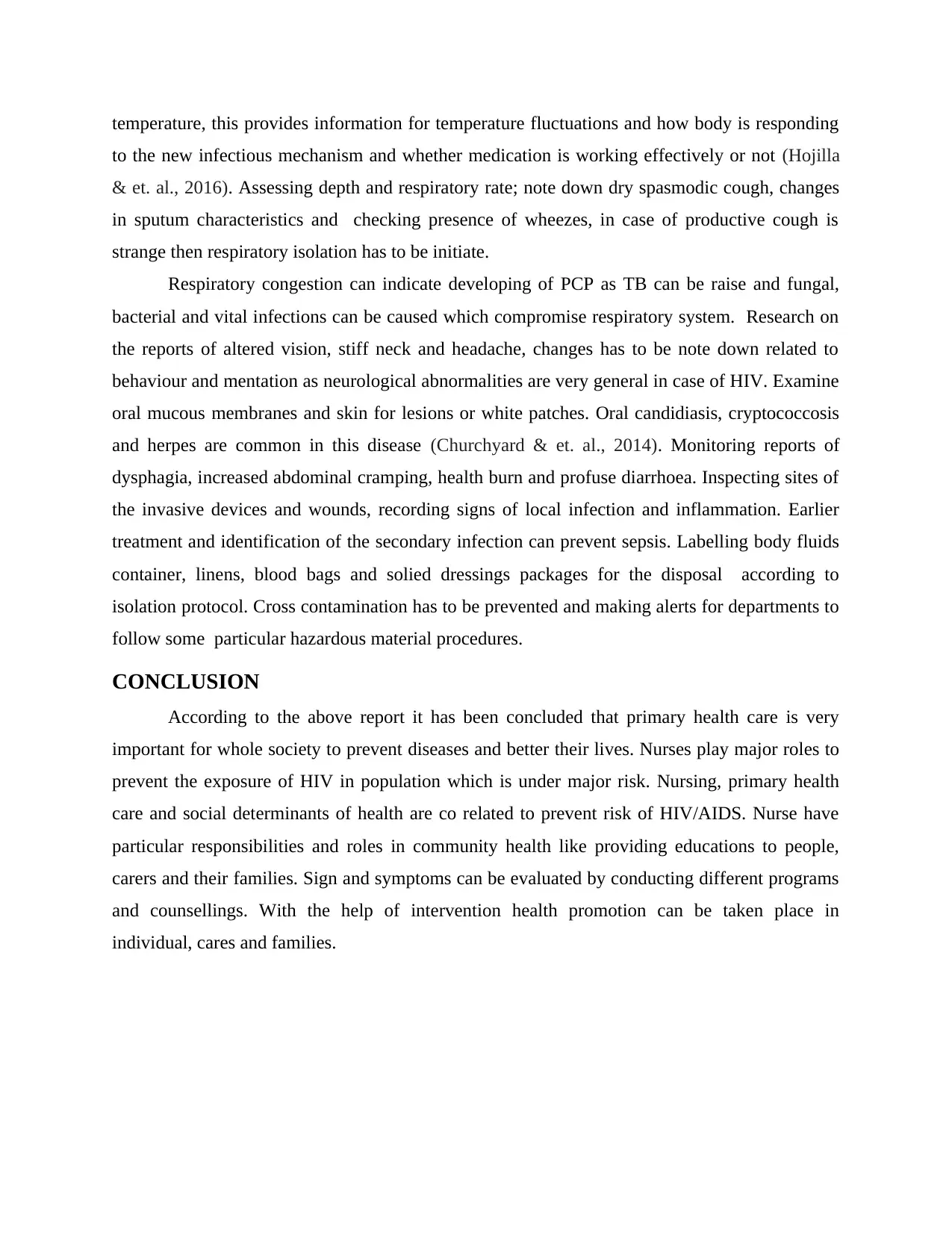
temperature, this provides information for temperature fluctuations and how body is responding
to the new infectious mechanism and whether medication is working effectively or not (Hojilla
& et. al., 2016). Assessing depth and respiratory rate; note down dry spasmodic cough, changes
in sputum characteristics and checking presence of wheezes, in case of productive cough is
strange then respiratory isolation has to be initiate.
Respiratory congestion can indicate developing of PCP as TB can be raise and fungal,
bacterial and vital infections can be caused which compromise respiratory system. Research on
the reports of altered vision, stiff neck and headache, changes has to be note down related to
behaviour and mentation as neurological abnormalities are very general in case of HIV. Examine
oral mucous membranes and skin for lesions or white patches. Oral candidiasis, cryptococcosis
and herpes are common in this disease (Churchyard & et. al., 2014). Monitoring reports of
dysphagia, increased abdominal cramping, health burn and profuse diarrhoea. Inspecting sites of
the invasive devices and wounds, recording signs of local infection and inflammation. Earlier
treatment and identification of the secondary infection can prevent sepsis. Labelling body fluids
container, linens, blood bags and solied dressings packages for the disposal according to
isolation protocol. Cross contamination has to be prevented and making alerts for departments to
follow some particular hazardous material procedures.
CONCLUSION
According to the above report it has been concluded that primary health care is very
important for whole society to prevent diseases and better their lives. Nurses play major roles to
prevent the exposure of HIV in population which is under major risk. Nursing, primary health
care and social determinants of health are co related to prevent risk of HIV/AIDS. Nurse have
particular responsibilities and roles in community health like providing educations to people,
carers and their families. Sign and symptoms can be evaluated by conducting different programs
and counsellings. With the help of intervention health promotion can be taken place in
individual, cares and families.
to the new infectious mechanism and whether medication is working effectively or not (Hojilla
& et. al., 2016). Assessing depth and respiratory rate; note down dry spasmodic cough, changes
in sputum characteristics and checking presence of wheezes, in case of productive cough is
strange then respiratory isolation has to be initiate.
Respiratory congestion can indicate developing of PCP as TB can be raise and fungal,
bacterial and vital infections can be caused which compromise respiratory system. Research on
the reports of altered vision, stiff neck and headache, changes has to be note down related to
behaviour and mentation as neurological abnormalities are very general in case of HIV. Examine
oral mucous membranes and skin for lesions or white patches. Oral candidiasis, cryptococcosis
and herpes are common in this disease (Churchyard & et. al., 2014). Monitoring reports of
dysphagia, increased abdominal cramping, health burn and profuse diarrhoea. Inspecting sites of
the invasive devices and wounds, recording signs of local infection and inflammation. Earlier
treatment and identification of the secondary infection can prevent sepsis. Labelling body fluids
container, linens, blood bags and solied dressings packages for the disposal according to
isolation protocol. Cross contamination has to be prevented and making alerts for departments to
follow some particular hazardous material procedures.
CONCLUSION
According to the above report it has been concluded that primary health care is very
important for whole society to prevent diseases and better their lives. Nurses play major roles to
prevent the exposure of HIV in population which is under major risk. Nursing, primary health
care and social determinants of health are co related to prevent risk of HIV/AIDS. Nurse have
particular responsibilities and roles in community health like providing educations to people,
carers and their families. Sign and symptoms can be evaluated by conducting different programs
and counsellings. With the help of intervention health promotion can be taken place in
individual, cares and families.
Paraphrase This Document
Need a fresh take? Get an instant paraphrase of this document with our AI Paraphraser
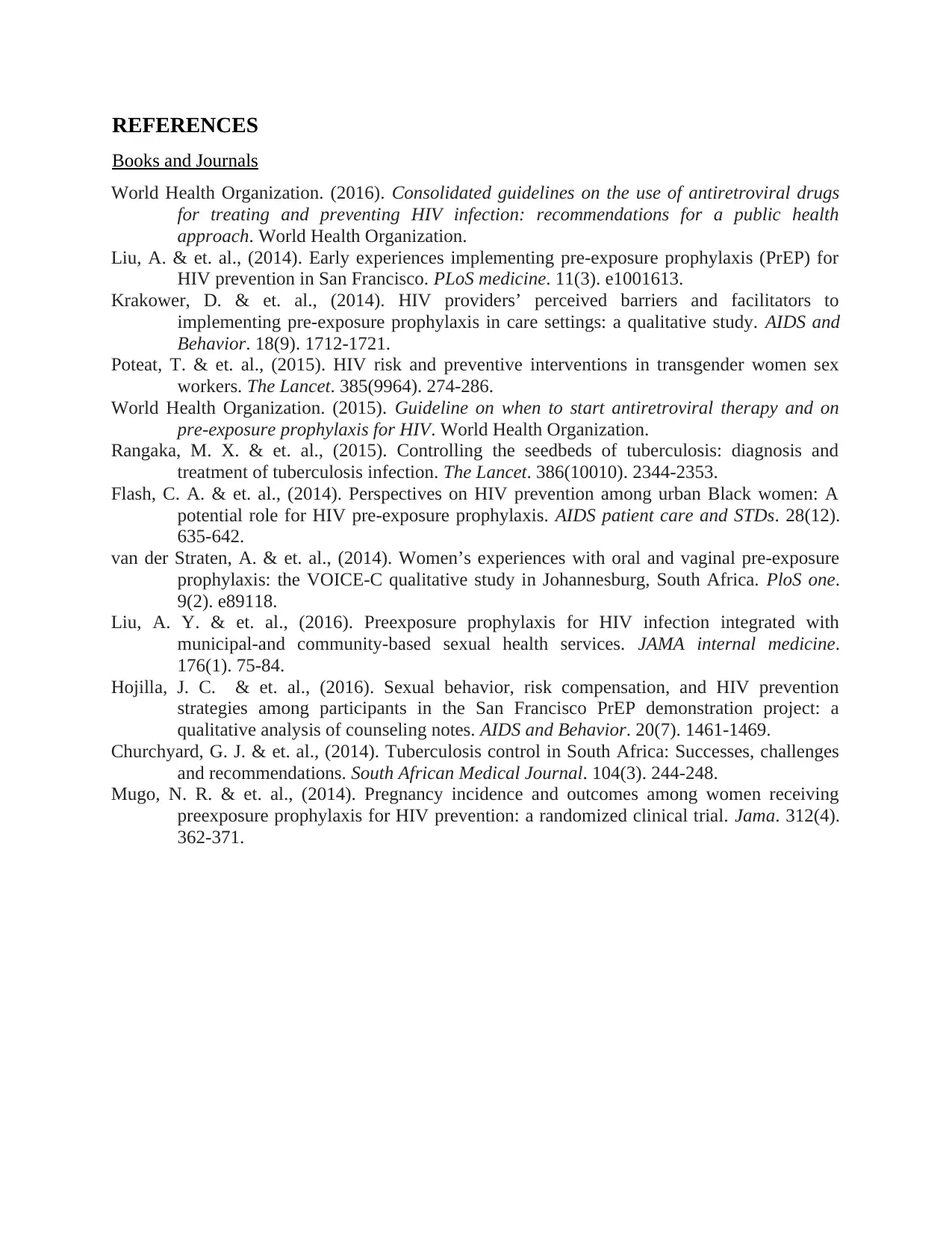
REFERENCES
Books and Journals
World Health Organization. (2016). Consolidated guidelines on the use of antiretroviral drugs
for treating and preventing HIV infection: recommendations for a public health
approach. World Health Organization.
Liu, A. & et. al., (2014). Early experiences implementing pre-exposure prophylaxis (PrEP) for
HIV prevention in San Francisco. PLoS medicine. 11(3). e1001613.
Krakower, D. & et. al., (2014). HIV providers’ perceived barriers and facilitators to
implementing pre-exposure prophylaxis in care settings: a qualitative study. AIDS and
Behavior. 18(9). 1712-1721.
Poteat, T. & et. al., (2015). HIV risk and preventive interventions in transgender women sex
workers. The Lancet. 385(9964). 274-286.
World Health Organization. (2015). Guideline on when to start antiretroviral therapy and on
pre-exposure prophylaxis for HIV. World Health Organization.
Rangaka, M. X. & et. al., (2015). Controlling the seedbeds of tuberculosis: diagnosis and
treatment of tuberculosis infection. The Lancet. 386(10010). 2344-2353.
Flash, C. A. & et. al., (2014). Perspectives on HIV prevention among urban Black women: A
potential role for HIV pre-exposure prophylaxis. AIDS patient care and STDs. 28(12).
635-642.
van der Straten, A. & et. al., (2014). Women’s experiences with oral and vaginal pre-exposure
prophylaxis: the VOICE-C qualitative study in Johannesburg, South Africa. PloS one.
9(2). e89118.
Liu, A. Y. & et. al., (2016). Preexposure prophylaxis for HIV infection integrated with
municipal-and community-based sexual health services. JAMA internal medicine.
176(1). 75-84.
Hojilla, J. C. & et. al., (2016). Sexual behavior, risk compensation, and HIV prevention
strategies among participants in the San Francisco PrEP demonstration project: a
qualitative analysis of counseling notes. AIDS and Behavior. 20(7). 1461-1469.
Churchyard, G. J. & et. al., (2014). Tuberculosis control in South Africa: Successes, challenges
and recommendations. South African Medical Journal. 104(3). 244-248.
Mugo, N. R. & et. al., (2014). Pregnancy incidence and outcomes among women receiving
preexposure prophylaxis for HIV prevention: a randomized clinical trial. Jama. 312(4).
362-371.
Books and Journals
World Health Organization. (2016). Consolidated guidelines on the use of antiretroviral drugs
for treating and preventing HIV infection: recommendations for a public health
approach. World Health Organization.
Liu, A. & et. al., (2014). Early experiences implementing pre-exposure prophylaxis (PrEP) for
HIV prevention in San Francisco. PLoS medicine. 11(3). e1001613.
Krakower, D. & et. al., (2014). HIV providers’ perceived barriers and facilitators to
implementing pre-exposure prophylaxis in care settings: a qualitative study. AIDS and
Behavior. 18(9). 1712-1721.
Poteat, T. & et. al., (2015). HIV risk and preventive interventions in transgender women sex
workers. The Lancet. 385(9964). 274-286.
World Health Organization. (2015). Guideline on when to start antiretroviral therapy and on
pre-exposure prophylaxis for HIV. World Health Organization.
Rangaka, M. X. & et. al., (2015). Controlling the seedbeds of tuberculosis: diagnosis and
treatment of tuberculosis infection. The Lancet. 386(10010). 2344-2353.
Flash, C. A. & et. al., (2014). Perspectives on HIV prevention among urban Black women: A
potential role for HIV pre-exposure prophylaxis. AIDS patient care and STDs. 28(12).
635-642.
van der Straten, A. & et. al., (2014). Women’s experiences with oral and vaginal pre-exposure
prophylaxis: the VOICE-C qualitative study in Johannesburg, South Africa. PloS one.
9(2). e89118.
Liu, A. Y. & et. al., (2016). Preexposure prophylaxis for HIV infection integrated with
municipal-and community-based sexual health services. JAMA internal medicine.
176(1). 75-84.
Hojilla, J. C. & et. al., (2016). Sexual behavior, risk compensation, and HIV prevention
strategies among participants in the San Francisco PrEP demonstration project: a
qualitative analysis of counseling notes. AIDS and Behavior. 20(7). 1461-1469.
Churchyard, G. J. & et. al., (2014). Tuberculosis control in South Africa: Successes, challenges
and recommendations. South African Medical Journal. 104(3). 244-248.
Mugo, N. R. & et. al., (2014). Pregnancy incidence and outcomes among women receiving
preexposure prophylaxis for HIV prevention: a randomized clinical trial. Jama. 312(4).
362-371.

1
⊘ This is a preview!⊘
Do you want full access?
Subscribe today to unlock all pages.

Trusted by 1+ million students worldwide

2
1 out of 10
Related Documents
Your All-in-One AI-Powered Toolkit for Academic Success.
+13062052269
info@desklib.com
Available 24*7 on WhatsApp / Email
![[object Object]](/_next/static/media/star-bottom.7253800d.svg)
Unlock your academic potential
Copyright © 2020–2025 A2Z Services. All Rights Reserved. Developed and managed by ZUCOL.




